No items in shopping pack.
March 6, 2023
Grab Your Gear: Turkey Hunting Checklist
Share:

Early perennials are popping up. Buds will be blooming soon. Spring is around the corner. The upcoming change in season brings something more exciting than flowers and rain showers for the avid hunter. It brings spring turkey hunting season.
Last season may have left your hunting gear in disarray. How’s that turkey vest or pack looking? Can you find all your calls? Make sure you have the right equipment ready, whether you’re itching for the season to start in your area or heading into the woods.
Mark equipment off your list. Follow our turkey hunting checklist below.
Jump to:
- Essentials: Inside the Vest or Pack
- Clothing: Camouflage Yourself in Layers
- Must-Haves: Additional Equipment
- Find a Turkey Hunt
Essentials: Inside the Turkey Hunting Vest or Pack
A turkey hunter’s best friend is their vest. When donning a vest or small pack, be sure you toe the line between preparation and mobility.
You want to carry enough gear to be ready for anything but not so much that you feel weighed down. And the last thing you want to do is rattle or clunk when you walk!
Check off these items. When packing your pockets, we recommend you carry the following gear:
- Shotgun shells
- Binoculars
- Turkey calls
- Clippers or pruners (for pesky foliage!)
- Small folding knife
- Insect repellent
- First aid kit
- Snacks and water for the day
- Cell phone (on silent for emergencies)
Types of Turkey Hunting Calls
Your main task on a turkey hunt is to coax birds into range. To do so, you’ll need an arsenal of trusted turkey calls.
Start by packing calls you are comfortable using unless practicing new calls is your focus. You should bring a variety of calls to best join in on the hens’ flow of conversation. You’ll mimic hens as they yelp, cluck and purr.
There are several types of turkey calls, including:
- Box calls – A box call may look simple but it can make a variety of noises. You can produce many sounds when you scrape the call’s lid against the box.
- Button calls – Beginner? Try a button call! They are easy to use. Press the call’s spring-loaded dowel to create sounds.
- Slate calls – These pot calls include a round disc and a striker. You use the striker to make a sound by rubbing it against the disc. You need both hands to use one.
- Diaphragm calls – These calls are also referred to as mouth calls. You blow air through the call to make noise. You can use them without your hands, making it easy to ready your shotgun or bow.
- Locator calls – You can’t turkey hunt without a locator call! Use an owl or crow call to get a response from a gobbler and find out where he is.
Clothing: Camouflage Yourself in Layers
What you wear turkey hunting is extremely important. You want to be warm and dry while remaining out of sight.
Turkeys have excellent vision. They can catch movement and see colors. One sign of something suspicious and your gobbler will run for the hills.
Dressing in camouflage from head to toe will hide you from a turkey’s all-seeing eyes. Many hunters use face paint, hats or masks to conceal their faces. They also use gloves, even when the weather is warm, to further hide their movements.
You’ll need the following clothing items:
- Camo jacket or vest
- Camo pants
- Waterproof boots
- Wool socks
- Gloves
- Hat or face mask
How to Layer Turkey Hunting Gear
Wet spring weather calls for layering your clothes. Layering lets you stay warm without feeling bulky. It also allows you to remove layers if you get too hot.
Here’s how to layer up:
- Start with a base layer. Your base layer wicks away sweat, keeping you dry. Avoid cotton t-shirts as a base layer. Cotton absorbs moisture and hangs onto it, making clothes feel wet and heavy. Choose wool or synthetic materials for your base layer.
- Add a mid-layer. Next, you need a layer for added warmth. Your base layer can be a long-sleeve t-shirt or a sweatshirt. Keep this layer breathable too! You want moisture to be pulled away from you.
- Add outerwear. Top your hunting attire off with a wind- and water-resistant jacket, vest or coat. Bibs could also serve as a warm outer layer. Insulated jackets are a great choice for super-cold days. On warmer, rainy days, go for a jacket with a light waterproof shell to ward off drizzle.
Must-Haves: Additional Equipment
What other equipment do you need? If you’re hunting with a shotgun, check the state’s regulations. Most turkey hunters use a 12-gauge shotgun. Younger hunters may prefer a smaller 20-gauge.
If you prefer bow hunting, opt for broadheads which help kill turkeys quickly.
Other items you need include:
- A valid hunting license and tag (a legal must!)
- Cushion or knee pads
- Shotgun rest or bow stand
- GPS or map and compass
- Watch
Once you’re dressed and packed, you’re ready to go. If you need spring turkey hunting tips for beginners, feel free to email [email protected] or message us on Instagram or Facebook.
Book a Turkey Hunt
Be ready for turkey hunting season. Know where you’ll hunt and when. You can schedule a hunt for you and your buddies directly from HUUNT.com.
Sign up today to book your next turkey hunt. We can hear the gobblers already!
Start Your Adventure Today
We make it simple to list and lease land, book guided hunts and more. Find your next hunting spot or guided trip. Earn extra income by letting others enjoy your land. HUUNT helps you make the most of every opportunity. Become a member today!